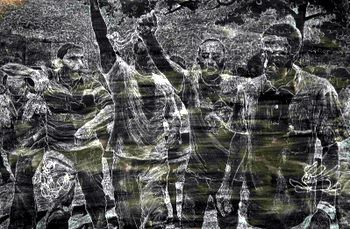DPM Gallery,
Oct 01, 2008 - Nov 05, 2008
Guayaquil-Miami, Ecuador
upcoming
by Rodolfo Kronfle
It’s clear that the synergy of all the above-mentioned characteristics aims to convey a complex discourse, with the ability to articulate different layers and levels of density. That’s why I think that as a whole Brito’s work implies a reappraisal of the viewer, who becomes a sense-multiplying agent. These paintings strive -despite all the initial thoughts put into them- to be assumed in different ways, even to the artist’s own surprise. In doing so, Brito is empowering the public and their readings as part of a creative act, derived from their particular and existential situation, affected by their cultural surroundings, their own biases, tastes, etc., but without imposing a particular discourse or univocal interpretation strand. Furthermore it seems that the artist assigns value to the temporality of the readings, based on the consciousness that conditions surrounding reception, and that actual events affecting that particular kind of reception, will be different in the mid to long terms ahead, thus starting new hermeneutical waves into the future (Surely, interpretations of this series obtained in Miami today will be different from those in Caracas at this moment, or from those to be ten years from now, in Havana).
Thus appears an essential part of Brito’s proposal, that of conceiving his production as an "open work" -in the same sense formulated by Umberto Eco, that is, of inexhaustible possibilities, of unlimited semiosis- with intertextuality as a preponderant factor, and where, regarding his sources, the artist expresses his preference of "not giving references away to avoid losing the possibility to keep superimposing interpretation, interpretation that becomes itself a need inevitably fostered by the work within you, the minute you’ve recognized that there is something there but you still don’t know exactly what it is."
Finally, attention must also be paid to the political character of the artist’s work, which is not given, curiously, by the way he adopts a clear or determined position within the system of impositions, consent and dissent that we deal with as individuals, or by a drive towards literal denouncing, or even less so by embracing any radical political transformation ideal, but instead in a sense that rather promotes -through aesthetic acts that reconfigure the perception of the issues he deals with- the springing of new subjective political visions in the viewer, achieved by dislocating the conventional point of view that each of us have concerning the collective environment.
What the artist seems to be stressing, beyond any particular reference, is what Rancire calls "the distribution of the sensible", which is defined as "the system of self-evident facts of sense perception that simultaneously discloses the existence of something in common and the delimitations that define the respective parts and positions within it"(4); in other words, what we expect about the roles and the parts that make an established political and social order. Tracing these perceptions and the changes these systems undergo throughout time -represented by particular events in Brito’s work- seems to be an almost philosophical approach under which much of the artist’s production has been conceived up to the present day.
Considering today’s ever-multiplying production of art trifle, we are left with the relief brought to us by the periodical presence of a serious artist: "All of my works have an ethical commitment. Behind each of them is the idea of thought, rigor, intellectual exercise and the complexity of discourse as opposed to the frivolity of producing art like candy."
Rodolfo Kronfle Chambers
Quotes:
(1) Each one having references to a specific theme like Bah’a de Cochinos, Las Damas de Blanco, etc.
(2) The title "Nacidos Vivos" aludes to the statistic of babies born alive, a measure of a countrys’ progress and development, an index that is permanently published in Cuba with a sense of pride; but it also can alude to a certain savviness, street smartness or adapting capabilities that most cubans show in dealing with any circumstance, it can paradoxically be seen as a way for survival, or -in an oposite sense but in a dialogue with the paintings- it can point out how the individual "dies" within these masses.
(3) It helps to recall here that renowned image of "The damned circumstance of water all around..." or "If I didn’t think water surrounds me like cancer ..." painted by Virgilio Piñera in his poem La isla en peso (1943-1944, The Weight of the Island).
(4) Rancire, Jacques. The politics of aesthetics, Continuum, New York-London, 2004, pp. 12, translated from the original by Gabriel Rockhill.
|









